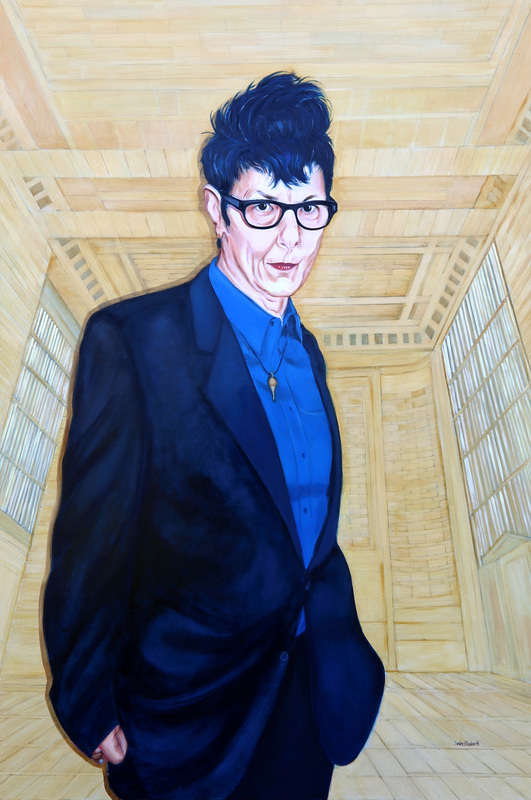
Elizabeth Streb, 2014
Oil on linen, 60” x 40”
Elizabeth Streb is an anomaly in the world of dance. She began choreographing and performing upon her arrival in New York in 1975, including risk in all of her performances; risk that engages the audience and connects them to that moment. The works, which she calls “popaction,” are influenced by the circus, rodeo, and daredevil stunts. Streb approaches her choreography as a scientist might, studying the effects of gravity, math, and physics on movement. Streb’s background included extreme sports and that influence of skiing and motorcycling is apparent in her work. In 2003, she established SLAM (STREB Lab for Action Mechanics) in Brooklyn where rehearsals are open to the community – she also provides classes where the public can learn to fly. Her choreography consists of diving off 16-foot high metal scaffolding or launching performers through the air in quick succession. The performances incorporate custom-made trapezes, trusses, trampolines and even a flying machine. As focus turned more to her than the performance, Streb stopped performing in 2010 to keep the spotlight on the company. She is a MacArthur Foundation ‘Genius Award’ recipient. STREB’s company performs in theatres, festivals, and serves as ‘artists in residence’ in world-class art museums. In 2012, Streb was commissioned by the Olympic and Paralympic Games and the Mayor of London to participate in the London 2012 Festival where the company dancers performed events at major landmarks including the Millennium Bridge and Trafalgar Square. Streb’s choreography and the STREB Extreme Action Company are chronicled in director Catherine Gund’s documentary Born to Fly.
I met Elizabeth Streb in August 2000 when she and her company used Vanderbilt Hall as a rehearsal space, allowing the public to view them as they passed through Grand Central Terminal. At the end of the month, the company presented their work to an audience. It was an amazing performance and I have been a fan ever since, always wanting to paint Elizabeth. I ran into her a couple years ago and shared this desire. She stopped by a few days later and we naturally gravitated to Vanderbilt Hall where she shared how important the space was to her and how the performances there in many ways changed the size of her audience, in effect capturing an audience of a grand scale.
Oil on linen, 60” x 40”
Elizabeth Streb is an anomaly in the world of dance. She began choreographing and performing upon her arrival in New York in 1975, including risk in all of her performances; risk that engages the audience and connects them to that moment. The works, which she calls “popaction,” are influenced by the circus, rodeo, and daredevil stunts. Streb approaches her choreography as a scientist might, studying the effects of gravity, math, and physics on movement. Streb’s background included extreme sports and that influence of skiing and motorcycling is apparent in her work. In 2003, she established SLAM (STREB Lab for Action Mechanics) in Brooklyn where rehearsals are open to the community – she also provides classes where the public can learn to fly. Her choreography consists of diving off 16-foot high metal scaffolding or launching performers through the air in quick succession. The performances incorporate custom-made trapezes, trusses, trampolines and even a flying machine. As focus turned more to her than the performance, Streb stopped performing in 2010 to keep the spotlight on the company. She is a MacArthur Foundation ‘Genius Award’ recipient. STREB’s company performs in theatres, festivals, and serves as ‘artists in residence’ in world-class art museums. In 2012, Streb was commissioned by the Olympic and Paralympic Games and the Mayor of London to participate in the London 2012 Festival where the company dancers performed events at major landmarks including the Millennium Bridge and Trafalgar Square. Streb’s choreography and the STREB Extreme Action Company are chronicled in director Catherine Gund’s documentary Born to Fly.
I met Elizabeth Streb in August 2000 when she and her company used Vanderbilt Hall as a rehearsal space, allowing the public to view them as they passed through Grand Central Terminal. At the end of the month, the company presented their work to an audience. It was an amazing performance and I have been a fan ever since, always wanting to paint Elizabeth. I ran into her a couple years ago and shared this desire. She stopped by a few days later and we naturally gravitated to Vanderbilt Hall where she shared how important the space was to her and how the performances there in many ways changed the size of her audience, in effect capturing an audience of a grand scale.